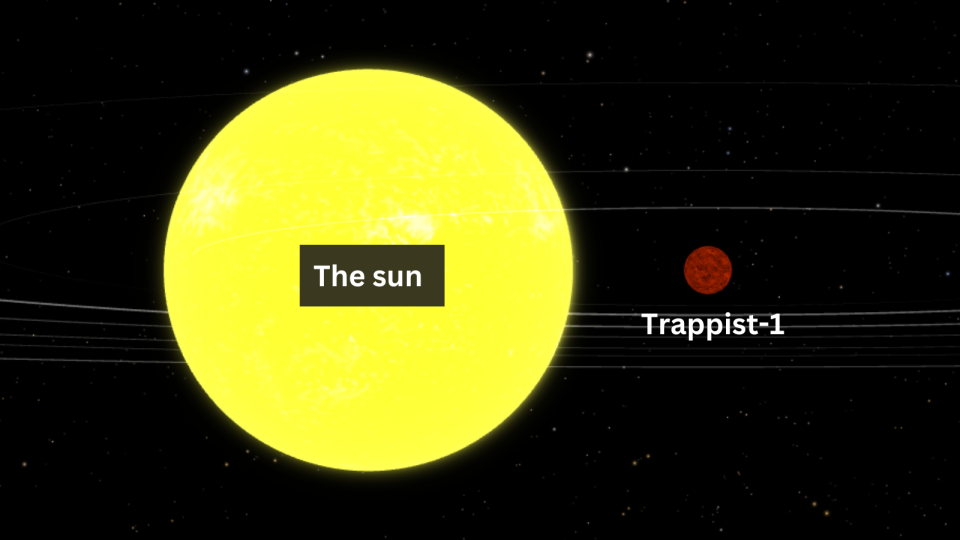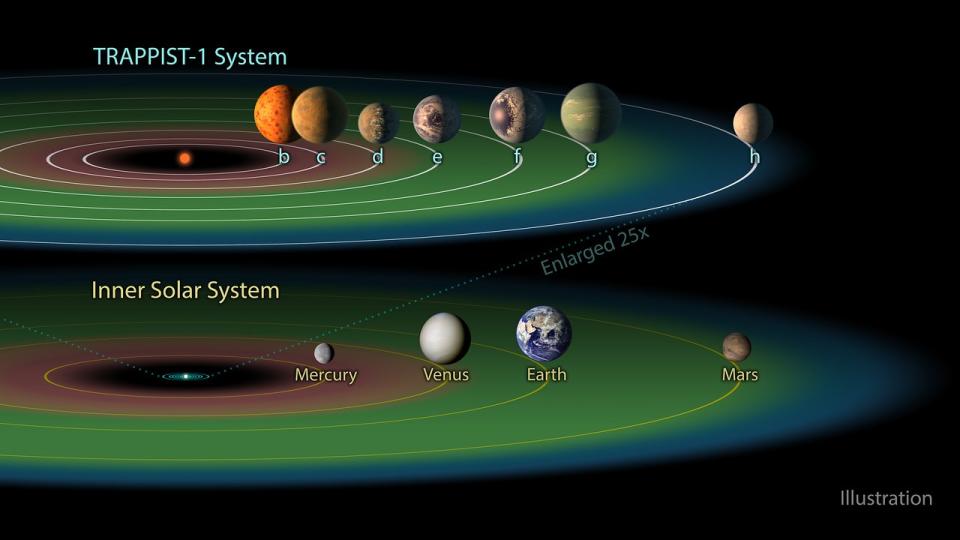Scientists have discovered that a potentially habitable planet has been stripped of its atmosphere; This is a process that could eventually make the world, Trappist-1e, and life uninhabitable. The stripping appears to be caused by electrical currents generated as the planet orbits its red dwarf host star.
This is an important discovery because the Trappist-1 system, where this exoplanet orbits a small red dwarf star, has been one of the primary targets in the search for alien life. At least 3 of the seven rocky Earth-like worlds in the system lie in the habitable zone around a star, which is neither too hot nor too cold to allow a planet to support liquid water.
But a planet without an atmosphere cannot hold liquid water, even if it is in the habitable zone, also known as the “Goldilocks zone.” This suggests that although Trappist-1e is in the habitable zone of the red dwarf Trappist-1, located 40 light-years from Earth, its habitability may be temporary.
The same phenomenon affecting Trappist-1e’s atmosphere may also be affecting the atmospheres of other planets in this habitable zone, which is bad news for the possibility of finding life in this system.
Relating to: James Webb Space Telescope, this TRAPPIST-1 exoplanet appears to have no atmosphere; reveals that truth may be hiding inside your star
Ways to strip an exoplanet’s atmosphere
Although Trappist-1e is roughly the size of Earth, it is about 0.7 times the mass of our planet. The fourth planet from its star, it orbits at a distance of only 0.028 times the distance between Earth and the sun and completes one orbit in just 6.1 Earth days.
Despite this proximity, Trappist-1 is much smaller and cooler than the Sun, so its habitable zone is much closer to its surface than our star’s habitable zone. To that end, it’s not radiation from this red dwarf that’s stripping TRAPPIST-1e’s atmosphere, but rather a wind of charged particles blown from the star, called the “stellar wind.”
“We looked at how space weather changes along the planet’s orbit, with TRAPPIST-1e switching very quickly between very different stellar wind conditions and pressures, leading to a kind of pulsed compression and relaxation of the planet’s magnetic field,” said the team at Cecilia Garraffo. member and an astrophysicist from Harvard & Smithsonian told Space.com. “This activates strong electrical currents in the upper atmosphere (ionosphere) that heat the atmosphere, just like an electric heater.”

Garraffo explained that Earth is also experiencing changes in the solar wind, causing similar warming in our atmosphere. The difference is that the warming felt by TRAPPIST-1e is 100,000 times stronger than what Earth experiences from solar winds from the sun. This is because Trappist-1e is moving rapidly around its star, and the motion sets off strong ionospheric currents that dissipate and create superheating, which the team calls “voltage-driven Joule heating.”
Although the team predicted this effect in 2017, researchers were surprised to see how strong it was.
“For TRAPPIST-1e, it could be so strong that the heat essentially evaporates the upper atmosphere,” Garraffo said. “Over millions of years, the planet may completely lose its atmosphere due to this event.”
The team’s research shows that there are several different ways a planet can lose its atmosphere.
It is generally believed that the loss of exoplanet atmospheres is caused by some external process, team member and Lowell Center for Space Science and Technology researcher Ofer Cohen told Space.com. This includes strong radiation from the star, which can cause the atmosphere to heat up and escape, or charged particles thrown at planets by the stellar wind, which causes a strong stripping effect.
“In this case, the heating of the atmosphere and the resulting loss is due solely to the rapid movement of the planet. Therefore, the planet is doomed to lose its atmosphere simply by moving,” Cohen said. “It’s like when we’re too lazy to clear the roof of our car from the snow and we start driving, hoping that the air circulating around the car will do the job for us and lift the snow—at least that’s what we do in the Boston area.
“I think it’s pretty cool that planets can do this with their atmospheres.”
What about the other Trappist-1 planets?
On Earth, our magnetosphere protects our atmosphere by directing charged particles into magnetic field lines and behind our planet. Lacking a strong magnetic field, Mars’ atmosphere has been stripped away by solar winds and harsh solar radiation. In fact, the Red Planet probably lost its water to space as a result.
Trappist-1e is also believed to have a magnetosphere, but these findings suggest this may not be sufficient to prevent atmospheric stripping.
“Normally a planet’s magnetic field acts like a protective bubble, but around TRAPPIST-1e this bubble is compromised. The planet’s magnetic field couples to the star’s magnetic field, creating paths that allow the star’s particles to hit the planet directly,” Garraffo said. “This not only destroys the atmosphere, but also warms it significantly, leaving TRAPPIST-1e and its neighbors vulnerable to losing their atmosphere entirely.”


Trappist-1e is the fourth planet from a red dwarf star at the heart of this fascinating planetary system of rocky worlds. Astronomers had previously discovered that Trappist-1b, the closest exoplanet to the star, appeared to have lost its atmosphere.
The team thinks that voltage-dependent Joule heating may also affect Trappist-1f and Trappist-1g, stripping them of their atmospheres, but to a lesser extent than what they saw in Trappist-1e. This is because these planets, which are 0.038 and 0.04683 times the distance between the Earth and the sun, respectively, from the star, move more slowly along the red dwarf’s stellar winds than Trappist-1e.
“The fates of planets closer to Trappist-1 will be even tougher, while those further away will be a little more gentle,” Garraffo said. “I predict that all Trappist-1 planets will have difficulty retaining any atmosphere.”
Related Stories:
— Study shows exoplanets in the Trappist-1 system are more likely to be habitable than scientists once thought
— TRAPPIST-1 solar system not bombarded by space rocks like early Earth, study finds
— James Webb Space Telescope could help find habitable alien worlds
The team’s findings may also have implications for the search for habitable exoplanets outside the Trappist-1 system and life outside the solar system. They suggest that exoplanets close to their star have likely lost their atmospheres, even if they are in that star’s habitable zone.
The results could also help reveal which stars might host planets with molecules that indicate the presence of life: biomarkers.
“Our research suggests that such low-mass stars are probably not the most promising stars for hosting planets with atmospheres,” Garraffo concluded. “To determine which stars might be conducive to habitable planets and to observe these atmospheric transits with the James Webb Space Telescope and future observatories, while developing the technology to interpret these results in terms of biomarkers.”
The team’s research was published Feb. 16 in the Astrophysical Journal.